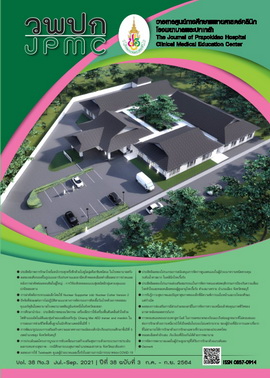The study of efficacy of Botulinum toxin A in hemifacial spasm in Trang Hospital
Main Article Content
Abstract
BACKGROUND: Hemifacial spasm (HFS) is a common movement disorder in Thailand. It can result in physical disability as well as emotional and social problems of the patients. Although botulinum toxin A is currently used for the treatment of HFS, there are still very few published clinical reports of its efficacy and studies on the quality of life before and after its use.
OBJECTIVES: To evaluate the impact of botulinum toxin A on the function, quality of life, and its efficacy, as well as investigate its side effects in HFS in Trang Hospital, Trang Province, Thailand for a period of 10 years.
METHODS: A retrospective and descriptive study was used to evaluate the treatment outcomes of HFS patients in the Department of Physical Medicine and Rehabilitation in Trang Hospital. The evaluation of the treatment efficacy included the assessment of the peak improvement (0 - 100%) subjectively evaluated at 28 days after the injection session by each patient, the response time to the treatment, and the results and side effects of the treatment. The patients treated with botulinum toxin A were evaluated for the treatment before and 28 days after receiving their first injection by answering the questionnaires: the six - point disability scale and the Thai HFS - 30. In this study, the analysis of the data was performed by descriptive statistics and the Wilcoxon matched - pairs signed ranks test.
RESULTS: A total of 56 patients with HFS were treated with 824 botulinum toxin A treatments. The mean duration of the symptoms was 3.5 years. The sites of injection were the orbicularis oculi and orbicularis oris muscles. The mean dose of all treatments was 22.1 units. The peak improvement of the treatment was assessed between four and six weeks after the first botulinum toxin A injections was 84.6%. There was a statistically significant improvement in the six - point disability rating scale and Thai HFS - 30 in the duration before the treatment. The most common side effect was facial paresis (2.3%). All side effects were transient and lasted from one to four weeks after the injections.
CONCLUSIONS: Botulinum toxin A proved to be an effective treatment for HFS, and it also yielded an improvement in the quality of life of the patients in Trang Hospital.
Article Details
References
Green KE, Rastall D, Eggenberger E. Treatment of blepharospasm/hemifacial spasm. Curr Treat Options Neurol 2017;19:41.
Öcal R, Tunç T, Ayas ZÖ, Yılmaz Ö, İnan LE. Comparison of brain MRI angiography and brain MRI cisternography in patients with hemifacial spasm. Acta Neurol Belg 2016; 116: 593-8.
Rosenstengel C, Matthes M, Baldauf J, Fleck S, Schroeder H. Hemifacial spasm: conservative and surgical treatment options. Dtsch Arztebl Int 2012 ;109:667-73.
Bartindale M, Mohamed A, Bell J, Kircher M, Hill J, Anderson D, et al. Neurotologic complications following microvascular decompression: a retrospective study. J Neurol Surg B Skull Base 2020;81:37-42.
Setthawatcharawanich S, Ovartlanporn S. Effective treatment of hemifacial spasm and blepharospasm with botulinum toxin type A in Songklanagarind hospital. Songkla Med J 2007; 25:191–9.
Batisti JPM, Kleinfelder ADF, Galli NB, Moro A, Munhoz RP, Teive HAG. Treatment of hemifacial spasm with botulinum toxin type a: effective, long lasting and well tolerated. Arq Neuropsiquiatr 2017;75:87-91.
Suputtitada A, Phanthumchinda K, Locharernkul C, Suwanwela NC. Hemifacial spasm: results of treatment with low dose botulinum toxin injection. J Med Assoc Thai 2004;87:1205-11.
Ababneh OH, Cetinkaya A, Kulwin DR. Long-term efficacy and safety of botulinum toxin A injections to treat blepharospasm and hemifacial spasm. Clin Exp Ophthalmol 2014;42: 254- 61.
Hallett M, Albanese A, Dressler D, Segal KR, Simpson DM, Truong D, et al. Evidence-based review and assessment of botulinum neurotoxin for the treatment of movement disorders. Toxicon 2013 ;67:94-114.
Streitová H, Bareš M. Long-term therapy of benign essential blepharospasm and facial hemispasm with botulinum toxin A: retrospective assessment of the clinical and quality of life impact in patients treated for more than 15 years. Acta Neurol Belg 2014 ;114:285-91.
Weiss D, Sturm J, Hieber L, Börtlein A, Mayr I, Appy M, et al.. Health-related quality of life outcomes from botulinum toxin treatment in hemifacial spasm. Ther Adv Neurol Disord 2017;10:211-6.
Tan EK, Fook-Chong S, Lum SY, Lim E. Botulinum toxin improves quality of life in hemifacial spasm: validation of a questionnaire (HFS-30). J Neurol Sci 2004;219:151-5.
Rungrot T, Kasemsap N, Tiamkao S. Quality of life in Thai patients with hemifacial spasm: comparative between four regional-referral hospitals. KKUJM 2015; 1(2): 28-34.
Drug and Medical Supply Information Center, Ministry of Public Health. Rational Guide Drug Use of the Thai National Formulary [Internet]. 2010 [cited 2021 Apr 3]. Available from: https://dpf.mod.go.th/pdf/บญชยาหลกแหงชาต-พ-ศ-2563.aspx
Setthawatcharawanich S, Aui-aree N, Limapichart K, Satirapunya P, Phabphal K. The validation of the disease-specific questionnaire for health-related quality of life in Thai patients with hemifacial spasm. J Med Assoc Thai 2008;91:1691-7.

